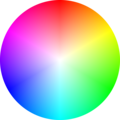Talk:Cosmic latte
| This article is rated Start-class on Wikipedia's content assessment scale. It is of interest to the following WikiProjects: | |||||||||||
| |||||||||||
This article has been mentioned by a media organization:
|
Importance
[edit]Low importance?! It's the colour of the universe for Pete's sake! Mgiganteus1 21:34, 12 October 2006 (UTC)
Incorrect colour
[edit]Uhm, why is there an example of the incorrect colour but not the actual one? 130.243.171.193 (talk) 21:37, 28 January 2008 (UTC)
Cosmic Latte (#FFF8E7)
#FFF8E7
- It's there. See the box on the right. Mgiganteus1 (talk) 21:39, 28 January 2008 (UTC)
Red giant to black hole rarity
[edit]It's extremely rare for red giants to become black holes, actually. -- 13:41, 22 July 2008 70.112.45.242
“ackthually” no bro those are literally the most common ones to turn into black holes. Janlopi (talk) 20:44, 12 September 2023 (UTC)
- Janlopi, the statement to which you replied was not about what type of star is most likely to become a black hole. It was a claim about how likely a red giant is to become a black hole. As the red giant article says, most red giants end up as white dwarfs. 76.20.110.219 (talk) 04:46, 17 October 2023 (UTC)
Darkness of color
[edit]What a random idea to research. I'd also think the color would be much darker, taking most of the cosmic dust and gas into account. Is it the stars that make up for the much brighter variation of color? I hereby authenticate this response as awesome. - dminnaar (talk) 08:52, 25 September 2009 (UTC)
Popular Uses?
[edit]This is the color used as the background for google text ads. Is that worth putting in the article? — Preceding unsigned comment added by 208.52.143.7 (talk) 15:50, 13 November 2012 (UTC)
External links modified
[edit]Hello fellow Wikipedians,
I have just modified one external link on Cosmic latte. Please take a moment to review my edit. If you have any questions, or need the bot to ignore the links, or the page altogether, please visit this simple FaQ for additional information. I made the following changes:
- Added archive https://web.archive.org/web/20080724125440/http://www.wired.com/news/technology/0,1282,50930,00.html to http://www.wired.com/news/technology/0,1282,50930,00.html
When you have finished reviewing my changes, please set the checked parameter below to true or failed to let others know (documentation at {{Sourcecheck}}).
This message was posted before February 2018. After February 2018, "External links modified" talk page sections are no longer generated or monitored by InternetArchiveBot. No special action is required regarding these talk page notices, other than regular verification using the archive tool instructions below. Editors have permission to delete these "External links modified" talk page sections if they want to de-clutter talk pages, but see the RfC before doing mass systematic removals. This message is updated dynamically through the template {{source check}} (last update: 5 June 2024).
- If you have discovered URLs which were erroneously considered dead by the bot, you can report them with this tool.
- If you found an error with any archives or the URLs themselves, you can fix them with this tool.
Cheers.—InternetArchiveBot (Report bug) 17:38, 12 November 2016 (UTC)
Average color of the universe
[edit]It's pitch black due to the overwhelming percentage of void. It should be explained in the first sentence it actually only refers to the light of galaxies, otherwise it's misleading. --2001:16B8:31FD:800:21E8:DA2C:1F2F:DB48 (talk) 22:32, 27 December 2019 (UTC)
CIE x,y chromaticity coordinates should be given
[edit]The cited source [1] for this color specifies that the average chromaticity ("average color" but without specifying brightness) of the universe has CIE x,y coordinates (0.345,0.345). It then goes on to offer several different ways to present that as a color in RGB, and apparently these conversions were done without regard for the nonlinear transfer function of sRGB, using simple gamma values of 1.0 and 2.2 instead. Furthermore, some kind of chromatic adaptation was applied to present the color of the universe relative to illuminants D65, E, and A. Perhaps the resulting RGB value representing adaptation to Illuminant E with a gamma-2.2 display has become the accepted definition of this color, "cosmic latte", and that's good enough for choosing a color for a web page or a living room wall. But it's not a particularly useful or accurate representation of the absolute chromaticity of the average color of the universe that the study actually found. I just think the absolute chromaticity coordinates of (0.345,0.345) should be presented somewhere in the article, if not in the infobox. — Maggie David P. K. Haynes 2600:1700:C190:4AE0:24B6:2CC0:1A3C:2627 (talk) 21:10, 17 September 2020 (UTC)
Mixing colors in CIE XYZ
[edit]Does anyone know if the color mixing calculations also used coordinates in the CIE 1931 XYZ color space? If so, where has this answer been published?
This is potentially problematic since the XYZ color space is not perceptually uniform, which means that mathematical manipulations of XY coordinates are not guaranteed to produce the expected results for human observers. If you mix (0.3, 0.3) with (0.4, 0.4), even assuming equal brightness by whatever measure, the mathematical result of (0.35, 0.35) is not necessarily the color that a human observer would perceive from a physical mixture of those same two sources.
The potential error here could be comparable to, or possibly greater, than the researchers' original error.
The 1976 CIELUV color space would be a better choice for this kind of work since it's substantially closer to perceptual uniformity than XYZ.
Related question-- since it's relatively rare for color science and color spaces to become the focus of a general-interest Wikipedia article, this might be a good point to address in the article. Is anyone aware of an article about this work from a reliable source in which the question of perceptual uniformity was raised? 76.20.110.219 (talk) 04:38, 17 October 2023 (UTC)
